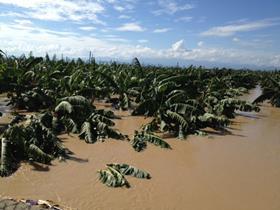
The Philippine banana industry is counting the cost of Typhoon Bopha, which cut a swathe of devastation through Mindanao island on Tuesday.
The typhoon, which has claimed several hundred lives and left around 200,000 homeless, caused a trail of destruction as hurricane-force winds brought torrential rain that triggered a deadly combination of floods and landslides.
The lower reaches of Mindanao where the vast majority of Philippine bananas are grown have always steered clear of significant typhoon damage, but this time they were in the direct path of the storm.
Wide swathes of hillsides in Davao Oriental and Compostela Valley provinces, the epicentre of the banana industry, were flattened by the winds and flash floods.
Industry officials estimate that some 10,000ha of banana plantations have been destroyed or damaged by the storms.
According to figures from Stephen Antig, executive director of the Pilipino Banana Growers and Exporters Association, that damage would represent close to a quarter of industry plantings, which he put at 42,000ha.
But Remigio Garcia, chairman of the Mindanao Banana Farmers & Exporters Association, whose organisation represents independent growers and small farmers, told Asiafruit the total area under production for export in the Philippines amounted to roughly 70,000ha, with the members of the Pilipino Banana Growers and Exporters Association accounting for 42,000ha.
Unprecedented damage
Garcia predicted that some 30m boxes of bananas would be lost as a result of the 10,000ha of plantations taken out of production, costing the industry around US$120m in lost export revenue.
“It’ll be 10 months before these plantations can start harvesting again,” he noted, adding that the damage was unprecedented for the Philippine banana industry.
“It’s the first time our industry has experienced this kind of a typhoon. Davao and Compostela Valley are not usually in the path. In all my 43 years in the industry I have not experienced anything of this magnitude.”
In addition to the lost export revenue, Garcia said the industry had to contend with the cost of rehabilitating plantings, which he put at a further P3.5bn (US$87.5m).
Antig’s estimate of the damage bill was greater, predicting the Philippine industry had lost P8bn (US$200m) in ruined harvests and damaged facilities, and putting the cost of rehabilitating farms at P5bn (US$125m).
Floods could spread Panama disease
In addition to the visible damage, there are concerns in the industry that the floods have spread the deadly Panama disease.
“Around 2,000ha were flooded, mainly in the Asuncion and Kapalong municipalities, and our worry is if water comes from plantations with Panama disease, these plantations will soon become affected,” said Garcia.
While industry officials are confident of the industry’s ability to bounce back, how the rehabilitation will be funded remains unclear, especially as growers do not have insurance.
“No growers have insurance because the premium is prohibitive and the production regions are not usually in the path of typhoons,” explained Garcia.
Calls for compensation
Garcia is due to discuss the issue of compensation today (7 December) during talks with the Philippine trade and industry secretary who is accompanying president Benigno ‘Noynoy’ Aquino III on a visit to typhoon ravaged Mindanao.
“We’re talking to the government about financial assistance today, and we’ll be asking for loans from the government or its conduit banks,” he told Asiafruit. “Even if growers are members of the industry organisations or contracted to supply multinational companies, I don’t think these groups will be able to extend the loans or financial assistance that are required for growers to rehabilitate their plantations.”
The damage to banana operations will also have a significant impact on local livelihoods, he added, given that the Philippine industry directly employs an estimated 140,000 people in production and packing operations. “We’re going to lose 20,000 jobs for the next 10 months, and that’s not including those in allied services like trucking or stevedoring,” said Garcia.
Supply shortages
Jeroen De Hass of banana exporter NEH Philippines – which estimates that it may have lost 18-20 per cent of its own production–predicted that supplies would run short for the next six months and prices would rise on the back of higher production costs resulting from the rehabilitation efforts.
“Some areas will take six or seven months to fully recover, others even up to a year as they’ve been completely wiped out and need complete rehabilitation,” he says. “For us, the impact is confined to a few farms, but others have lost larger plantations, especially in the Comval, Agusan and Surigao areas.”
A source from a leading player in the export sector, who declined to be named, said his company’s preliminary estimates suggested the typhoon had claimed around 23 per cent of national production. “We figure 700,000 boxes per week will drop out for the next 11 weeks,” he said.
Amid a likely export supply shortage, Garcia predicted that traditional markets such as Japan, Korea and the Middle East would take priority in the coming months.
That could mean China, the industry’s big growth market that has become problematic over the past year on account of its stringent quarantine measures, would lose out. “If China doesn’t relax its unreasonably strict quarantine procedures they’ll end up with no supply,” said Garcia.



